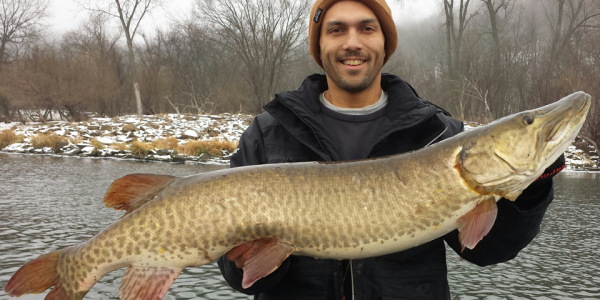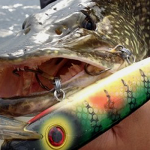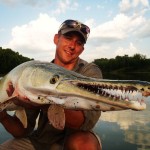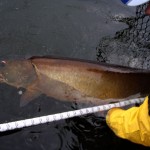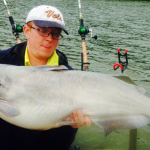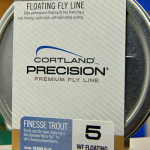By Adam M. Glickman
I grew up in northernmost WI in Ashland on the shores of Lake Superior’s Chequamegon Bay. My father and I fished heavily on lakes, streams, and rivers. Today, I continue to fish all types of water in the upper Midwest. I am a firm believer that the more types of water and individual waters I know the more successful I will be on any given day. This is because each type of water and individual water body reacts differently to seasonal progression, weather trends, and daily weather. Therefore, the more water types I am familiar with, the greater the chance I know one that is responding positively to the present and real time combination of the 3 previous mentioned factors.
I love all types of water. That being said, rivers and streams have really become my favored destinations over the past 5 years. I naturally gravitate toward them because they tend to have less fishing pressure than lakes and therefore the fish often bite better. However, my love for flowing waters goes beyond just that. I really enjoy presenting to current environments and observing current tolerant fish species in moving water.
Common current tolerant species that provide good opportunities for anglers in the upper Midwest include muskies, smallmouth bass, walleyes, trout, salmon, lake sturgeon, channel catfish, and redhorse suckers. Species that don’t care to use much, if any current, includes largemouth bass, northern pike, sunfish, crappie, flathead catfish, and common carp. These species will use current if necessary, but prefer slack water if it can be found.
Recently, I have gotten back into fishing for brown trout in streams and small rivers. When I moved to southern MN in 2006, I heard about trout fishing in the tributaries of the Mississippi River in SE MN and SW WI, but I scoffed at the notion for years. I grew up fishing the healthy and amazing trout waters of northern Wisconsin’s Lake Superior watershed, so I foolishly doubted how these farmland streams so far to the south could be any good. I tried them for the first time in 2015 and am happily a trout fisherman once again. It is a different game than in northern Wisconsin Great Lakes tributary fishing, but there are good numbers of fish and big individuals as well.
My point in all of this is after chasing muskies in rivers for so many years, then adding brown trout back to the list of species I regularly target, I was amazed at how similar pursuing the two species in rivers and streams really was. They prefer the same types of presentations (different sizes of course), the same holding areas, the same types of cover, and the same ambush styles. The only difference I have found is since brown trout prefer cooler water than muskies, they will use much faster areas in much cooler water. For example, muskies usually only use the really fast stuff when the water is past 70 F. When the water approaches 40 F they hold in calmer water directly adjacent to heavier current and use it to ambush prey. Brown trout, especially larger individuals, will use deeper slower pools for cover as long as temperature and oxygen levels are still in their desired range. If the water warms too much, they are forced to use faster often shallower areas.
In June, I was giving a seminar to a musky club on fishing muskies in rivers and streams. I was discussing “reading the water” and one audience member asked me if it was similar to fishing stream trout. I responded that it is almost exactly the same, and that if he is comfortable with fishing stream trout he is pretty much there already. He just needs to get used to throwing bigger tackle and presentations to river environments. In fact, fishing for musky, walleye, smallmouth, and brown trout in streams and rivers with artificial lures is all very similar. The only thing that sets them apart is their temperature tolerances and preferences and seasonal movements. Knowing these will allow one to better predict the locations of each species within a water body at any given time.
Migratory salmon and steelhead are perhaps the most current tolerant species of all, as they make long migrations at rapid speed overcoming seemingly impassible obstacles. Fishing for them in rivers however can be completely different as the fish are often very one minded in their reproductive migration and spawning process. This is why their pursuit often requires different consideration from the species mentioned in the previous paragraph.
Rough Fish
Channel catfish, redhorse suckers, and lake sturgeon are extremely current tolerant, but I classify them separately as well because they are usually targeted with stationary natural presentations. Channel catfish will strike artificial jigs, soft plastics, minnow baits, and crankbaits; but these are low percentage methods of catching them consistently. Redhorse can be caught on small artificial jigs and flies (more so in clear water), but I think this is more just an activity to prove angling skill rather than a reliable means of capturing the fish. I have seen a sturgeon legitimately hooked on a jigged blade bait on a TV show, and heard from a reliable source that one was caught on a trolled musky crankbait. The mouth of a sturgeon is so far behind the snout and on the bottom side of the head, it makes it difficult for them to eat anything that can move rapidly and isn’t directly underneath their head.
Muskies
Muskies are very current tolerant, and when on their reproductive migrations they are better at clearing tough obstacles than most would suspect. Some platforms at dams high off the water have fences around them to prevent muskies from beaching themselves on the platforms. Muskies do very well at 40-75 F depending on season. The warmer the water becomes, the faster and shallower the water they will move into. In Fact, in the mid 70’s F river muskies will often move into 1-2’ of shallow fast rocky water where the water has the most oxygen. Here they will tear after redhorse, ducks, muskrats, and fast moving presentations. Muskies Stress at 80 F and above and become very inactive though they will likely survive. As the water cools, muskies will prefer slower and slower water but will rarely completely abandon the current.
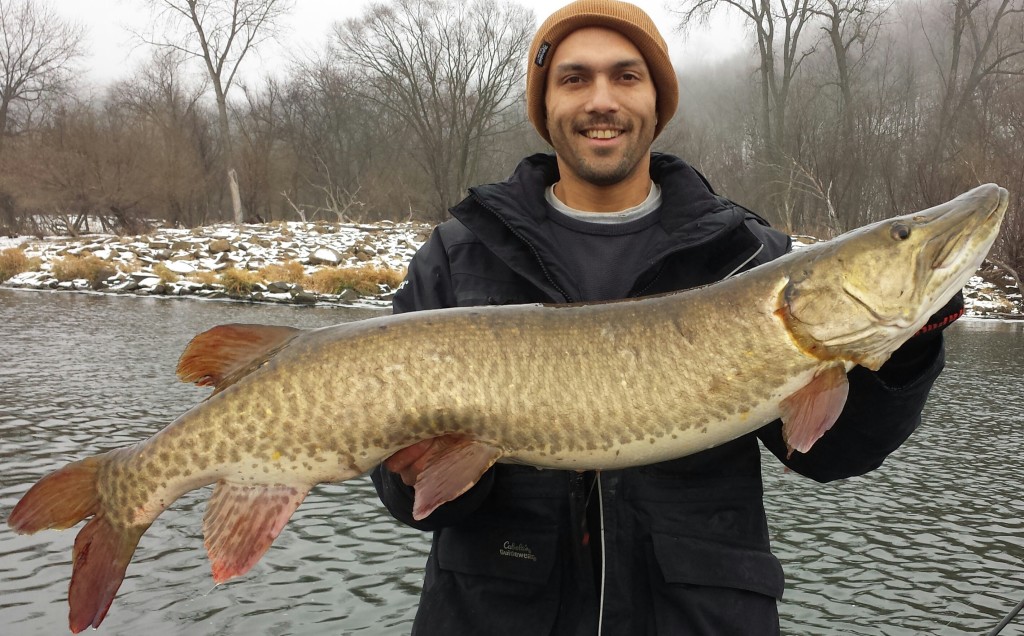
Smallmouth Bass
Smallmouth bass are highly active from 55-80 F. The lower end of that temperature range is great in the spring for trophy pre-spawn females and again for giants in early October. Like muskies temperature dictates desirable current speed. Cooler equals slower and warmer equals faster. As muskies stress in warmer water and seek out refuge locations to lay low, smallmouths still comfortable in the warm water often move into the prime feeding areas previously dominated by muskies. This is more noticeable in streams with larger populations of smaller muskies where there is more competition between the two.
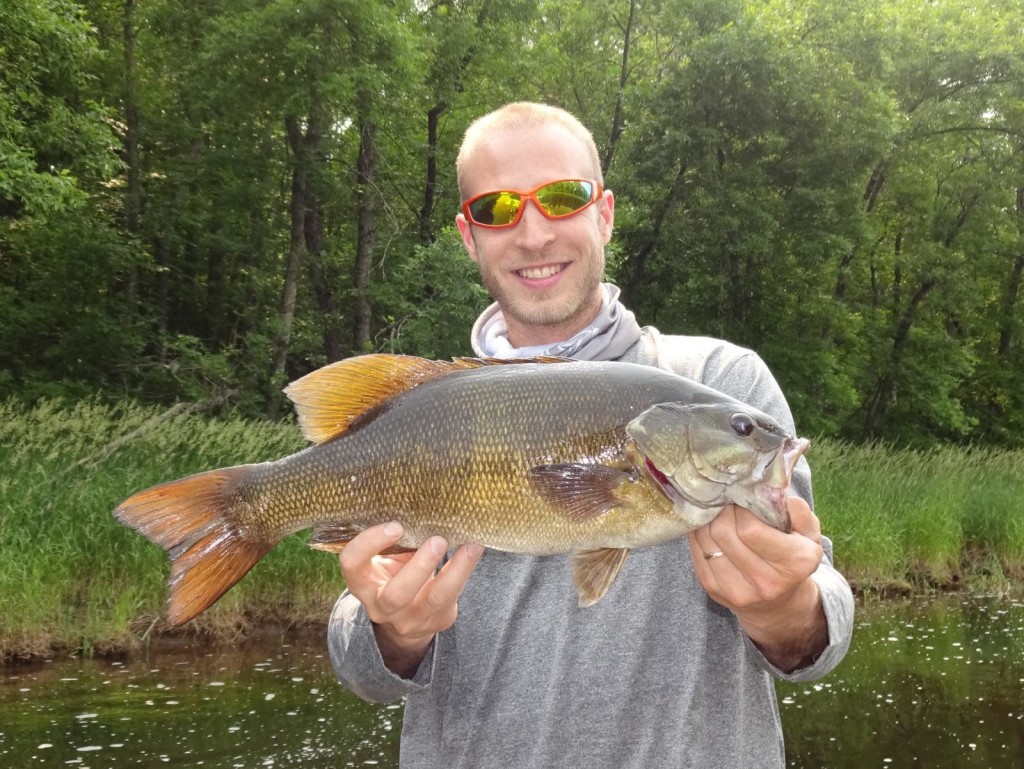
Walleyes
Walleyes have one of the largest ranges of preferred temperatures. The species has a reputation for being finicky, but opposite of what might be expected they are very hardy and are active and catchable from 40-80 F. In turbid water, walleyes will inhabit very shallow fast water. Similar to smallmouth, they will move into prime shallow areas as small and plentiful muskies retreat from warm water. Walleyes, being light sensitive, will come shallow to feed during low light or if the water is turbid or there is extensive wood cover for instance.
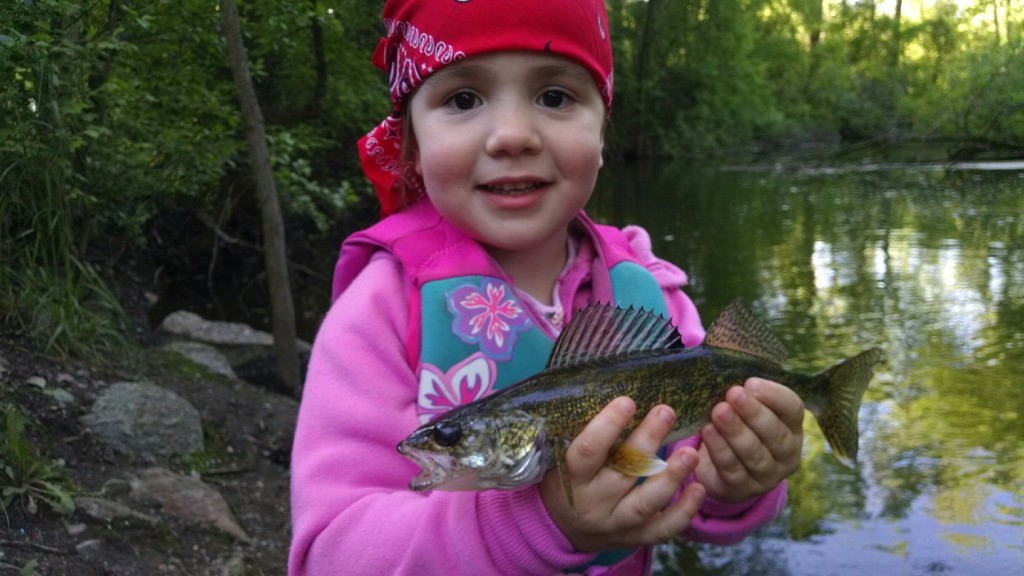
Brown Trout
Brown trout are technically a cool water fish even though they will tolerate warmer water than other trout. Brown trout activity is good from 38-65 F. As expected, brown trout will be found effectively predating in water even a little faster than smallmouth, walleye, or muskies. Bigger browns prefer more concealment and usually that means deeper often slower holes as long as they are cool and have sufficient oxygen. Big browns eat mostly other fish including smaller trout, though they are often targeted by fly fishermen with dry flies and nymphs. Often, anglers who don’t fly fish are a little intimidated at the prospect of trout fishing, but brown trout are readily caught on small Rapalas and Panther Martin spinners. I often clean house on #4 and #6 X-Raps and #6 and #8 Husky Jerks.
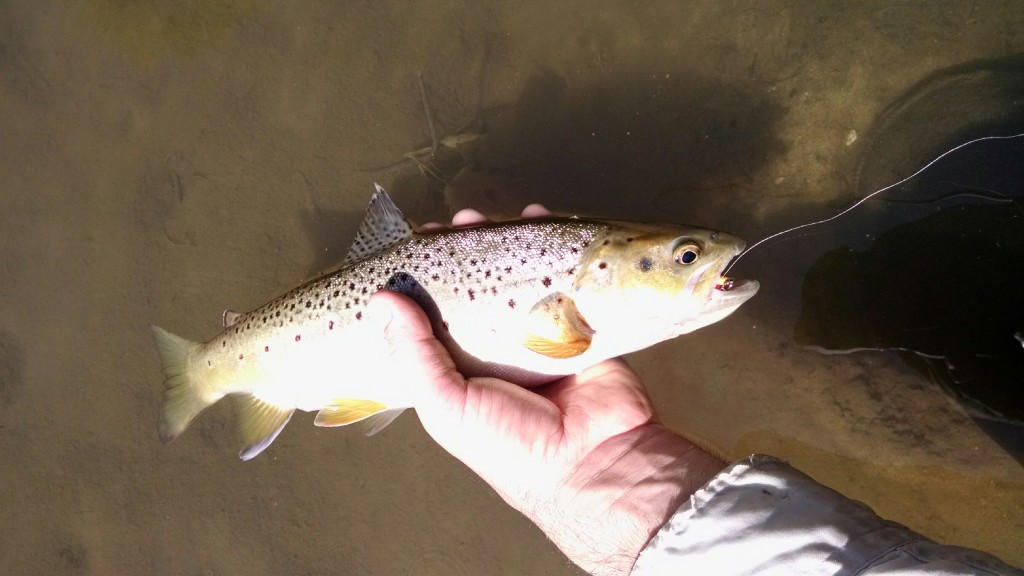
Lake Sturgeon
Lake sturgeon live, feed, and reproduce comfortably in swift water. Sturgeon have a voracious appetite and are easy to take strikes from when they are on the feed. Sturgeon congregate heavily below falls and dams in spring and can be seen spawning in large groups in shallow fast rocky water. Strurgeon feed most often in swift current over a bottom of gravel and small rocks, using a protractile mouth that looks very much like a short vacuum cleaner hose. They primarily eat insect larvae, crustaceans, mollusks, and bottom dwelling fish. They feed heaviest at night. Sturgeon are most active at 65 F or below so their feeding dwindles some during the heat of summer. Nightcrawlers and cut fish are usually the best baits to take bites from sturgeon. If sturgeon can be seen working the bottom with mouth protruding, gills flaring, and puffs of sediment and sand; ease back, cast to the area, and a bite is almost sure to come.
Channel Catfish
Channel catfish are found in areas of rivers with good current and sand, gravel, and rock bottoms. Abundant wood cover also makes an area more desirable. They are highly opportunistic feeders. Their diet consists of insects, insect larvae, crustaceans, mollusks, amphibians, and fish. Even large channel catfish will often have stomachs full of terrestrial white flies during a hatch. Surface feeding for a catfish is counterintuitive, but it is a regular occurrence. Live frogs, live 3-5” minnows and suckers, and good sized chunks of cut sucker are good offerings for channel cats, especially in areas with lots of bullheads and redhorse that will eat other baits before catfish can get to it.
Redhorse Suckers
Redhorse suckers are abundant, strong fighters, and will eat nightcrawler pieces at a wide range of temperatures. Spring through fall, they are almost always willing to bite. They are not good to eat, but they will provide good action for anyone just looking for a fish to stretch the line. Redhorse are great fish for kids, and are much better than bluegills for teaching young anglers how to handle larger more powerful fish. Redhorse are perfectly adapted to handle current, and usually inhabit swift gravely areas were they feed on nearly any small invertebrate.
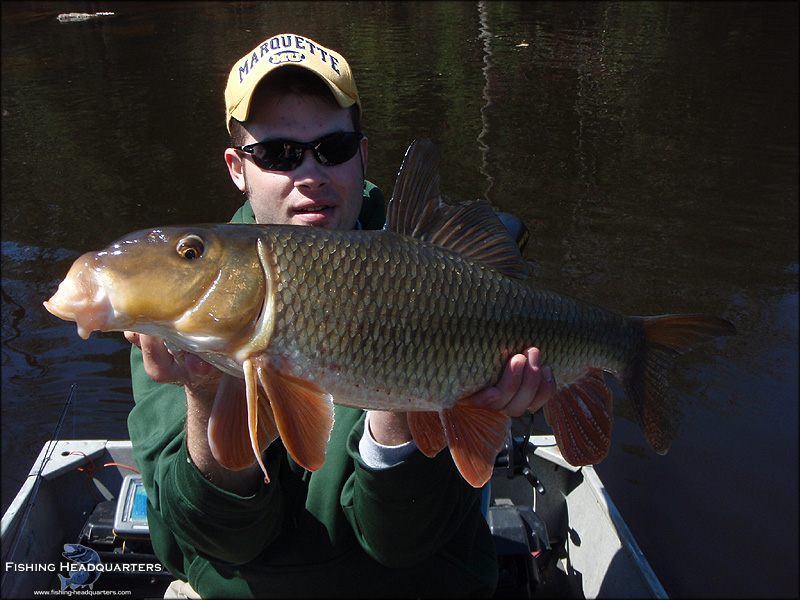
In the upper Midwest, many tributaries of Lake Michigan and Lake Superior get influxes of migratory salmon and steelhead. The current fighting ability of these fish is off the charts, and when hooked they usually fight like no other fish in the upper Midwest. Depending on the species and whether or not they are stocked or wild bred, aggression levels once in rivers range from high to almost nonexistent. Lake Michigan tributaries support very little to no natural reproduction, while some Lake Superior tributaries have completely self-sustaining populations of coho salmon, steelhead, and migratory brown trout. Wild populations that established decades ago are very different from fish that take hatchery effort to sustain. They have evolved in their introduced environments and have become much smaller, often only reaching 1/3-1/2 the size of their stocked counter parts. However, they are much more aggressive and pound for pound fight 2-3 times as hard.
Rivers and streams offer amazing fishing opportunities. They are often best accessible from shore or modest watercraft, which makes them great for people from all economic walks of life. Rivers and streams are often overlooked by most anglers which is hard to believe, because they offer some of the finest fishing available.
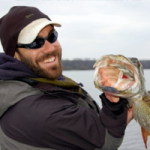 Adam M. Glickman
Adam M. Glickman
Adam Glickman, 33, originally from Ashland Wisconsin but now of the Minnesota Metro area, is field editor with Muskie Magazine, and a frequent contributor to Fishing-Headquarters and the online magazine. In 2014, Glickman began producing his new fishing program: Honest Musky Television is a unique, educational and entertaining fishing show. Our techniques are diverse, versatile, and often cost effective. We always get the strike and hookset on film, and in true honest musky fashion we use no fake hook sets or editing tricks. Glickman and his team films on a vast variety of aquatic environments from the smallest streams to the largest lakes, and done exclusively on public water, mostly in the Upper Midwest at affordable and realistic destinations.


